The global time temperature indicator labels market is projected to grow from USD 4.8 billion in 2025 to approximately USD 15.2 billion by 2035, recording an absolute increase of USD 10.4 billion over the forecast period. This translates into a total growth of 216.7%, with the market forecast to expand at a CAGR of 12.2% between 2025 and 2035.
The market size is expected to grow by approximately 3.2X during the same period, supported by increasing demand for cold chain monitoring, growing emphasis on food safety regulations, and rising adoption of smart packaging solutions across the pharmaceutical and food & beverage sectors.
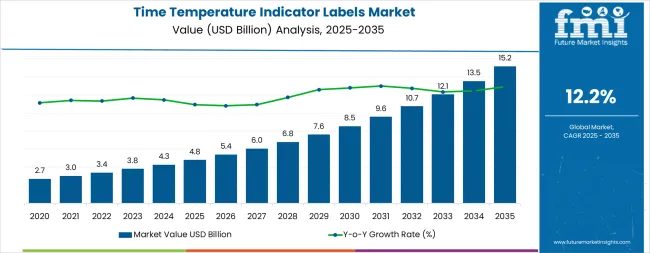
Between 2025 and 2030, the time-temperature indicator (TTI) labels market is projected to grow from USD 4.8 billion to USD 8.6 billion, adding USD 3.8 billion, or 36.5% of the total decade growth. This growth will be driven by increasing regulatory requirements for temperature-sensitive products, rising cold chain logistics complexity, and the growing availability of advanced TTI technologies across pharmaceutical and perishable goods supply chains.
Between 2030 and 2035, the market is forecast to expand further, from USD 8.6 billion to USD 15.2 billion, adding USD 6.6 billion, or 63.5% of the decade's growth. Key drivers will include the advancement of intelligent packaging technologies, IoT-enabled temperature monitoring systems, and cost-effective TTI solutions.
The focus will be on enhancing supply chain transparency, quality assurance, and improving TTI performance across extended temperature ranges. This will drive demand for indicators with enhanced accuracy, visual clarity, and superior functionality across diverse cold chain applications.
The packaging industry is the largest contributor, accounting for around 40-45%. TTI labels are increasingly integrated into packaging solutions across industries such as food and beverages, pharmaceuticals, and chemicals. These labels help monitor the temperature exposure of products, ensuring they remain within safe temperature ranges during storage, transport, and distribution.
The growing need for product traceability and maintaining product integrity is driving the demand for TTI labels, particularly in perishable goods packaging. The food and beverage market, contributing approximately 25-30%, plays a significant role as TTIs help monitor the temperature of perishable items like dairy products, meat, and frozen foods, ensuring freshness and safety for consumers.
The pharmaceutical market, accounting for around 15-20%, also contributes to the demand for TTI labels, especially for temperature-sensitive medicines, vaccines, and biologics. TTIs are essential in confirming that these products have been stored and transported under the required temperature conditions, ensuring efficacy and compliance with regulations.
The logistics and supply chain market, holding about 10-12%, uses TTI labels to track temperature-sensitive shipments, preventing exposure to harmful temperature fluctuations that could compromise the quality of products. Finally, the healthcare market, contributing around 5-8%, also benefits from TTI labels in the transportation of medical devices and diagnostic tools, ensuring proper storage conditions are maintained.
| Metric | Value |
|---|---|
| Estimated Value in (2025E) | USD 4.8 billion |
| Forecast Value in (2035F) | USD 15.2 billion |
| Forecast CAGR (2025 to 2035) | 12.2% |
Market expansion is being supported by the increasing global demand for cold chain integrity solutions and the corresponding shift toward intelligent packaging systems that can provide real-time temperature monitoring while meeting regulatory requirements for product safety and quality assurance.
Modern pharmaceutical manufacturers and food distributors are increasingly focused on incorporating monitoring solutions that can enhance product protection while satisfying demands for reliable, consistently performing indicators and compliance-optimized tracking practices. Time temperature indicator labels' proven ability to deliver temperature excursion detection, supply chain transparency, and diverse application possibilities makes them essential products for pharmaceutical logistics providers and cold chain operators.
The growing emphasis on regulatory compliance and product integrity is driving demand for high-quality indicator labels that can support distinctive monitoring outcomes and comprehensive quality positioning across pharmaceutical distribution, vaccine transport, and perishable food categories. Industry preference for solutions that combine accuracy excellence with visual clarity characteristics is creating opportunities for innovative indicator implementations in both traditional and emerging cold chain applications.
The rising influence of patient safety requirements and quality assurance initiatives is also contributing to increased adoption of indicator products that can provide authentic temperature monitoring and regulatory compliance characteristics.
The market is segmented by product type, technology, end-use industry, and region. By product type, the market is divided into full history indicators, partial history indicators, and critical temperature indicators. Based on technology, the market is categorized into enzymatic indicators, diffusion-based indicators, polymer-based indicators, and electrochemical indicators.
By end-use industry, the market includes pharmaceuticals, food & beverages, chemicals & fertilizers, and other industries. Regionally, the market is divided into North America, Europe, Asia Pacific, Latin America, Middle East & Africa, and other regions.
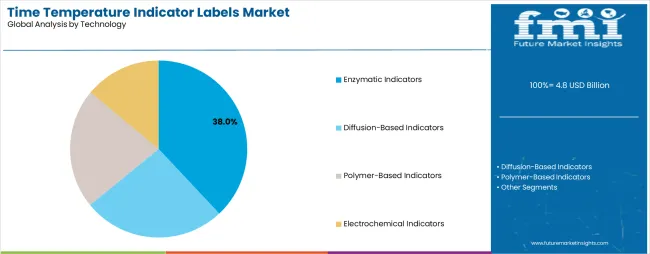
The full history indicators segment is projected to account for 46% of the time temperature indicator labels market in 2025, reaffirming its position as the leading product category. Pharmaceutical manufacturers and logistics providers increasingly utilize full history indicators for their comprehensive temperature tracking characteristics, established monitoring reliability, and essential functionality in regulatory compliance applications across diverse cold chain categories. Full history indicators' complete exposure documentation and proven temperature recording effectiveness directly address industry requirements for reliable audit trails and optimal quality assurance in pharmaceutical distribution applications.
This product segment forms the foundation of modern cold chain monitoring patterns, as it represents the format with the greatest regulatory acceptance potential and established compatibility across multiple pharmaceutical systems. Industry investments in quality optimization and compliance standardization continue to strengthen adoption among pharmaceutical logistics providers. With manufacturers prioritizing traceability and regulatory reliability, full history indicators align with both compliance objectives and quality performance requirements, making them the central component of comprehensive temperature monitoring strategies.
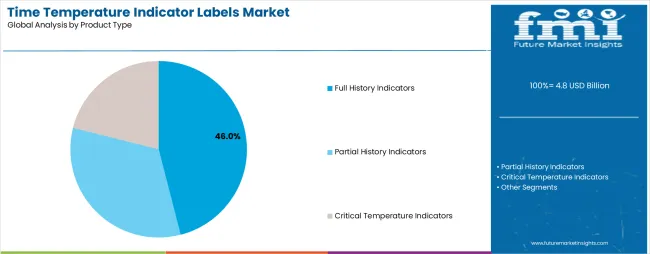
Enzymatic indicator products are projected to represent 38% of the time temperature indicator labels market growth through 2035, underscoring their critical role as the primary choice for accuracy-focused applications seeking superior monitoring precision and enhanced visual clarity.
Pharmaceutical manufacturers and premium logistics providers prefer enzymatic indicators for their enhanced accuracy standards, proven color change reliability, and ability to maintain exceptional visual contrast while supporting precise temperature monitoring during critical distribution experiences. Positioned as essential products for demanding applications, enzymatic offerings provide both monitoring excellence and interpretability advantages.
The segment is supported by continuous improvement in enzymatic chemistry and the widespread availability of established manufacturing infrastructure that enables accuracy assurance and premium positioning at the pharmaceutical level. Label manufacturers are optimizing enzymatic indicator formulations to support market differentiation and accessible premium pricing. As indicator technology continues to advance and industries seek superior monitoring solutions, enzymatic indicator products will continue to drive market growth while supporting quality optimization and regulatory compliance strategies.
The time temperature indicator labels market is advancing rapidly due to increasing cold chain complexity and growing need for temperature monitoring solutions that emphasize superior accuracy outcomes across pharmaceutical segments and food distribution applications. The market faces challenges, including higher implementation costs, limited standardization across indicator technologies, and integration complexities affecting adoption rates. Innovation in smart packaging techniques and specialized indicator development continues to influence market development and expansion patterns.
The growing adoption of time temperature indicators in specialized pharmaceutical programs and vaccine distribution applications is enabling logistics providers to develop monitoring patterns that provide distinctive compliance benefits while commanding premium positioning and enhanced traceability characteristics. Pharmaceutical applications provide superior regulatory assurance while allowing more sophisticated quality development across various cold chain categories. Manufacturers are increasingly recognizing the competitive advantages of indicator label positioning for premium compliance development and safety-conscious supply chain integration.
Modern indicator manufacturers are incorporating advanced data logging systems, IoT connectivity technologies, and cloud-based monitoring protocols to enhance tracking capabilities, improve real-time visibility, and meet industry demands for digital cold chain management. These systems improve monitoring effectiveness while enabling new applications, including predictive analytics and automated alert programs. Advanced digital integration also allows manufacturers to support premium market positioning and technology leadership beyond traditional indicator operations.
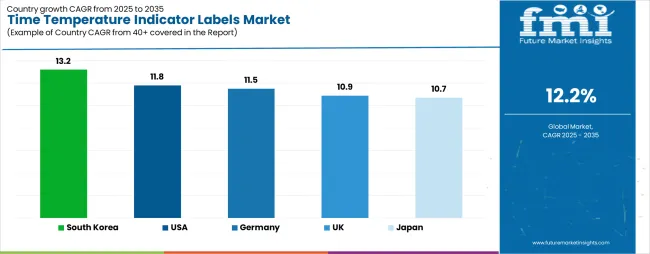
| Country | CAGR (2025 to 2035) |
|---|---|
| USA | 11.8% |
| Germany | 11.5% |
| UK | 10.9% |
| South Korea | 13.2% |
| Japan | 10.7% |
The time temperature indicator labels market is experiencing robust growth globally, with South Korea leading at a 13.2% CAGR through 2035, driven by the expanding pharmaceutical manufacturing sector, growing cold chain infrastructure, and increasing adoption of smart packaging technologies. The USA follows at 11.8%, supported by rising regulatory requirements, expanding biopharmaceutical logistics, and growing acceptance of advanced monitoring solutions.
Germany shows growth at 11.5%, emphasizing established pharmaceutical markets and comprehensive cold chain development. The UK records 10.9%, focusing on premium monitoring products and pharmaceutical distribution expansion. Japan demonstrates 10.7% growth, prioritizing quality indicator technologies and technological advancement.
The report covers an in-depth analysis of 40+ countries, with top-performing countries highlighted below.
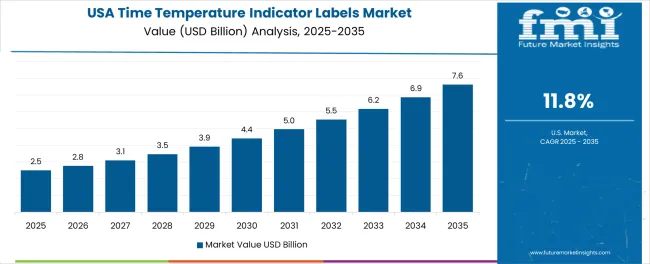
Revenue from time temperature indicator labels in the USA is projected to exhibit exceptional growth with a CAGR of 11.8% through 2035, driven by the country's rapidly expanding biopharmaceutical sector, favorable regulatory environment for temperature monitoring, and initiatives promoting cold chain optimization across major pharmaceutical distribution hubs.
The USA's position as a leading pharmaceutical market and increasing focus on vaccine distribution are creating substantial demand for high-quality indicator labels in both pharmaceutical and food logistics markets. Major pharmaceutical companies and specialized cold chain providers are establishing comprehensive monitoring capabilities to serve growing regulatory demand and emerging compliance opportunities.
Demand for time temperature indicator labels in Germany is expanding at a CAGR of 11.5%, supported by rising pharmaceutical sophistication, growing cold chain investment, and expanding logistics infrastructure. The country's developing pharmaceutical manufacturing capabilities and increasing industry investment in quality assurance are driving demand for indicator products across both imported and domestically produced applications. International pharmaceutical companies and domestic manufacturers are establishing comprehensive monitoring networks to address growing market demand for quality indicator labels and advanced cold chain solutions.
Revenue from time temperature indicator labels in the UK is projected to grow at a CAGR of 10.9% through 2035, supported by the country's mature pharmaceutical market, established regulatory framework, and leadership in cold chain management.
Britain's sophisticated pharmaceutical logistics infrastructure and strong support for quality monitoring are creating steady demand for both traditional and innovative indicator label varieties. Leading pharmaceutical companies and specialty logistics providers are establishing comprehensive operational strategies to serve both domestic markets and growing export opportunities.
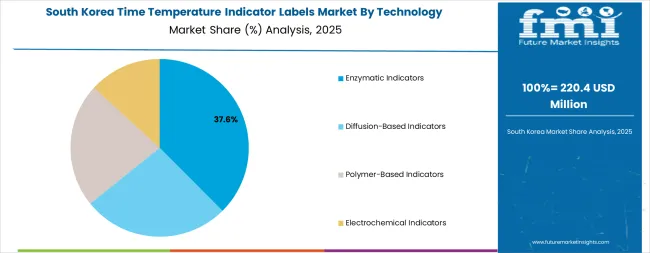
The sale time temperature indicator labels in South Korea are anticipated to grow at a CAGR of 13.2% through 2035, driven by the country's emphasis on advanced manufacturing, pharmaceutical technology leadership, and sophisticated industry preferences for quality monitoring solutions requiring specialized indicator varieties.
Korean pharmaceutical manufacturers and logistics providers consistently seek premium products that enhance supply chain integrity and support quality assurance for both traditional and innovative pharmaceutical applications. The country's position as an Asian technology leader continues to drive innovation in specialty indicator applications and premium product standards.
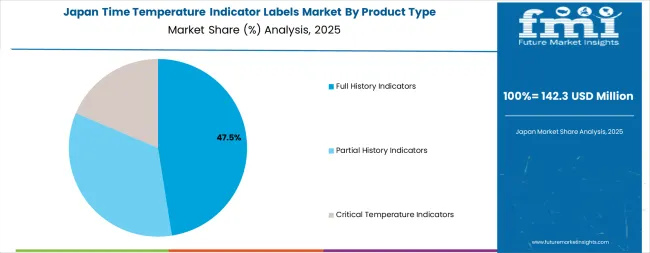
Revenue from time temperature indicator labels in Japan is expected to expand at a CAGR of 10.7% through 2035, supported by the country's emphasis on quality manufacturing, pharmaceutical safety standards, and advanced technology integration requiring efficient monitoring solutions.
Japanese pharmaceutical manufacturers and logistics professionals prioritize quality performance and precision monitoring, making indicator label products essential components for both traditional and modern pharmaceutical applications. The country's comprehensive pharmaceutical excellence and advancing distribution patterns support continued market expansion.
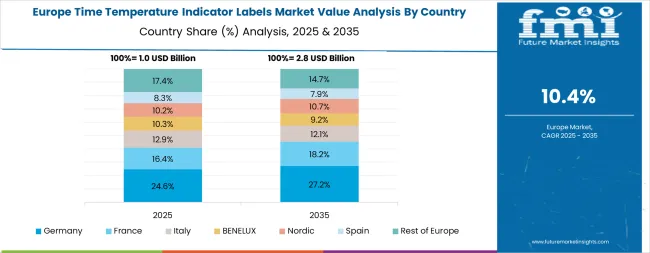
The Europe time temperature indicator labels market is projected to grow from USD 1.7 billion in 2025 to USD 3.8 billion by 2035, recording a CAGR of 8.4% over the forecast period. Germany leads the region with a 29.0% share in 2025, moderating slightly to 28.5% by 2035, supported by its strong pharmaceutical manufacturing base and demand for premium, precision-engineered indicator labels. France follows with 21.0% in 2025, easing to 20.5% by 2035, driven by a sophisticated pharmaceutical market and emphasis on quality and regulatory compliance.
The United Kingdom accounts for 19.5% in 2025, rising to 20.0% by 2035, reflecting steady adoption of monitoring products and regulatory consciousness. Italy holds 11.5% in 2025, expanding to 12.2% by 2035 as pharmaceutical logistics modernization and specialty cold chain applications grow.
Spain contributes 8.5% in 2025, growing to 9.0% by 2035, supported by expanding pharmaceutical manufacturing and premium logistics operations. The Nordic countries rise from 6.0% in 2025 to 6.5% by 2035 on the back of strong regulatory adoption and advanced cold chain integration. BENELUX remains a stable 4.5% share across both 2025 and 2035, reflecting mature, quality-focused markets.
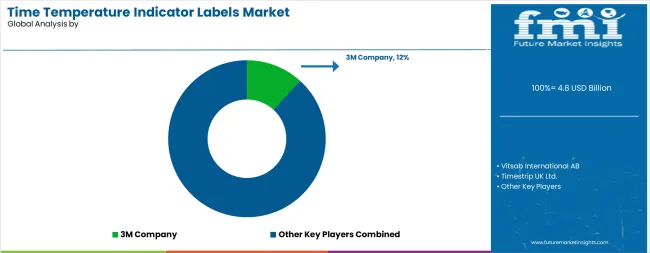
The time temperature indicator labels market is characterized by competition among established smart packaging companies, specialized indicator manufacturers, and integrated monitoring solution providers. Companies are investing in indicator chemistry technologies, advanced manufacturing systems, product innovation capabilities, and comprehensive distribution networks to deliver consistent, high-quality, and reliable temperature monitoring products. Innovation in accuracy enhancement, visual clarity improvement, and application-specific indicator development is central to strengthening market position and customer satisfaction.
3M Company leads the market with a strong focus on materials innovation and comprehensive smart packaging solutions, offering premium indicator products with emphasis on monitoring excellence and technology heritage. Vitsab International AB provides specialized enzymatic indicator capabilities with a focus on pharmaceutical market applications and cold chain networks.
Timestrip UK Ltd. delivers innovative time-based monitoring solutions with a focus on user-friendly positioning and operational efficiency. Cryolog S.A. specializes in comprehensive cold chain monitoring with an emphasis on pharmaceutical distribution applications. Temptime Corporation focuses on comprehensive indicator solutions with advanced chemistry formulations and premium positioning capabilities.
The success of time temperature indicator labels in meeting cold chain monitoring demands, regulatory compliance requirements, and quality assurance integration will not only enhance pharmaceutical safety outcomes but also strengthen global supply chain transparency capabilities. It will consolidate emerging regions' positions as hubs for efficient pharmaceutical manufacturing and align advanced economies with intelligent packaging systems. This calls for a concerted effort by all stakeholders - governments, industry bodies, suppliers, distributors, and investors. Each can be a crucial enabler in preparing the market for its next phase of growth.
How Governments Could Spur Local Production and Adoption?
How Industry Bodies Could Support Market Development?
How Distributors and Logistics Players Could Strengthen the Ecosystem?
How Suppliers Could Navigate the Shift?
| Items | Values |
|---|---|
| Quantitative Units (2025) | USD 4.8 billion |
| Product Type | Full History Indicators, Partial History Indicators, Critical Temperature Indicators |
| Technology | Enzymatic Indicators, Diffusion-Based Indicators, Polymer-Based Indicators, Electrochemical Indicators |
| End-Use Industry | Pharmaceuticals, Food & Beverages, Chemicals & Fertilizers, Other Industries |
| Regions Covered | North America, Europe, Asia Pacific, Latin America, Middle East & Africa, Other Regions |
| Countries Covered | United States, Germany, France, United Kingdom, Japan, South Korea, and 40+ countries |
| Key Companies Profiled | 3M Company, Vitsab International AB, Timestrip UK Ltd., Cryolog S.A., Temptime Corporation, and other leading indicator label companies |
| Additional Attributes | Dollar sales by product type, technology, end-use industry, and region; regional demand trends, competitive landscape, technological advancements in indicator chemistry, cold chain integration initiatives, accuracy enhancement programs, and premium product development strategies |
The global time temperature indicator labels market is estimated to be valued at USD 4.8 billion in 2025.
The market size for the time temperature indicator labels market is projected to reach USD 15.2 billion by 2035.
The time temperature indicator labels market is expected to grow at a 12.2% CAGR between 2025 and 2035.
The key product types in time temperature indicator labels market are full history indicators, partial history indicators and critical temperature indicators.
In terms of technology, enzymatic indicators segment to command 38.0% share in the time temperature indicator labels market in 2025.






Our Research Products

The "Full Research Suite" delivers actionable market intel, deep dives on markets or technologies, so clients act faster, cut risk, and unlock growth.

The Leaderboard benchmarks and ranks top vendors, classifying them as Established Leaders, Leading Challengers, or Disruptors & Challengers.

Locates where complements amplify value and substitutes erode it, forecasting net impact by horizon

We deliver granular, decision-grade intel: market sizing, 5-year forecasts, pricing, adoption, usage, revenue, and operational KPIs—plus competitor tracking, regulation, and value chains—across 60 countries broadly.

Spot the shifts before they hit your P&L. We track inflection points, adoption curves, pricing moves, and ecosystem plays to show where demand is heading, why it is changing, and what to do next across high-growth markets and disruptive tech

Real-time reads of user behavior. We track shifting priorities, perceptions of today’s and next-gen services, and provider experience, then pace how fast tech moves from trial to adoption, blending buyer, consumer, and channel inputs with social signals (#WhySwitch, #UX).

Partner with our analyst team to build a custom report designed around your business priorities. From analysing market trends to assessing competitors or crafting bespoke datasets, we tailor insights to your needs.
Supplier Intelligence
Discovery & Profiling
Capacity & Footprint
Performance & Risk
Compliance & Governance
Commercial Readiness
Who Supplies Whom
Scorecards & Shortlists
Playbooks & Docs
Category Intelligence
Definition & Scope
Demand & Use Cases
Cost Drivers
Market Structure
Supply Chain Map
Trade & Policy
Operating Norms
Deliverables
Buyer Intelligence
Account Basics
Spend & Scope
Procurement Model
Vendor Requirements
Terms & Policies
Entry Strategy
Pain Points & Triggers
Outputs
Pricing Analysis
Benchmarks
Trends
Should-Cost
Indexation
Landed Cost
Commercial Terms
Deliverables
Brand Analysis
Positioning & Value Prop
Share & Presence
Customer Evidence
Go-to-Market
Digital & Reputation
Compliance & Trust
KPIs & Gaps
Outputs
Full Research Suite comprises of:
Market outlook & trends analysis
Interviews & case studies
Strategic recommendations
Vendor profiles & capabilities analysis
5-year forecasts
8 regions and 60+ country-level data splits
Market segment data splits
12 months of continuous data updates
DELIVERED AS:
PDF EXCEL ONLINE
Evaluating Time Temperature Indicator Labels Market Share & Provider Insights
Time Temperature Indicator Label Industry Analysis in Western Europe Size and Share Forecast Outlook 2025 to 2035
Japan Time Temperature Indicator Label Industry Analysis by Product Type, Label Information, Technology, End-Use Industry, and Province through 2035
Korea Time Temperature Indicator Label Industry Analysis by Product Type, Label Information, Technology, End-Use Industry, and Province through 2035
Oxygen Indicator Labels Market Size and Share Forecast Outlook 2025 to 2035
Blood Temperature Indicator Market Size, Share & Forecast 2025 to 2035
Competitive Landscape of Blood Temperature Indicator Providers
Market Leaders & Share in Oxygen Indicator Labels Manufacturing
Ripeness Indicator Labels Market Size and Share Forecast Outlook 2025 to 2035
Colorimetric Indicator Labels Market Trends – Growth & Forecast 2024-2034
Time-Lapse Embryo Incubators Market Size and Share Forecast Outlook 2025 to 2035
Labels Market Forecast and Outlook 2025 to 2035
Temperature Controlled Pharmaceutical Packaging Solutions Market Forecast and Outlook 2025 to 2035
Temperature Monitoring Device Market Size and Share Forecast Outlook 2025 to 2035
Temperature Controlled Vaccine Packaging Market Size and Share Forecast Outlook 2025 to 2035
Temperature and Freshness Sensors Market Size and Share Forecast Outlook 2025 to 2035
Time Switch Market Analysis Size and Share Forecast Outlook 2025 to 2035
Time Sensitive Networking TSN Market Size and Share Forecast Outlook 2025 to 2035
Labels, Tapes And Films Market Size and Share Forecast Outlook 2025 to 2035
Time Of Flight Cameras Market Size and Share Forecast Outlook 2025 to 2035

Thank you!
You will receive an email from our Business Development Manager. Please be sure to check your SPAM/JUNK folder too.
Chat With
MaRIA